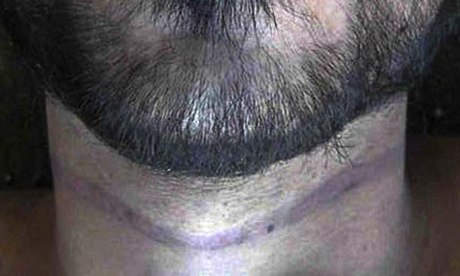By Darrin Simmons
Impunity Watch Reporter, Middle East
CAIRO, Egypt-On the third anniversary of the 2011 Egyptian revolution, at least 29 people have been killed throughout Egypt during nationwide protests. The worse violence has been directed at supporters of ousted President Mohamed Morsi.

Photos that showed at least nine dead bodies wrapped in shrouds were taken by two witnesses in the Al Maskan. There are reports of multiple deaths in this area, which is a neighborhood in eastern Cairo.
Other reports by witness tell of deadly clashes in Minya, Giza, Alexandria, and several other governorates. The Egyptian health ministry has reported that along with the 29 daeths, more than 170 were wounded by 8:30pm local time on Saturday.
Two explosions hit Cairo on early Saturday morning and a third followed in Suez, targeting police base. Armed groups also stage three attacks on security forces with the most notable bringing down a military helicopter in north Sinai.
Around noon, activists who opposed both the army and the Brotherhood, tried to take the streets during a rally in Cairo’s Mohandiseen district. They were eventually chased off only to reorganize several hours later downtown where security forces fired tear gas and live ammunition.
Fortunately, the main pro-military event in Cairo’s Tahrir Square was conducted peacefully. The event was protected by a heavy deployment of soldiers and police. The crowds gather in the square to celebrate General Abdel Fattah el-Sisi, the military chief who deposed Morsi in July.
During the gathering in Tahrir Square, army helicopters circled overhead and dropped Egyptian flags and coupons for free blankets. Crowds continued to arrive throughout the afternoon, many of them chanting “the people demand the execution of the Brotherhood.”
“We want to show that we won’t go back to the Brotherhood, and we won’t be scared by their terrorism. This is about correcting the path of the revolution,” stated one protesting arriving at the Square with a group of about 20 people.
“We aren’t sacred. All of the people of Port Said, of Egypt, we are down in the streets today,” reported another protester.
No claims of responsibility for Saturday’s attacks where received. These attacks followed a series of four bombings across the capital on Friday. The deadliest, a car bomb, tore through security forces, killing four people and injuring more than 70.
For more information, please see the following:
Al Jazeera-Dozens killed on Egypt uprising anniversary-26 January 2014
Euro News-Egypt: over two dozen dead in clashes on third anniversary of anti-Mubarak uprising-26 January 2014
Guardian-Egypt: protesters killed on anniversary of anti-Mubarak revolt-26 January 2014
National-At least 29 killed in clashes on Egyptian uprising anniversary-26 January 2014



